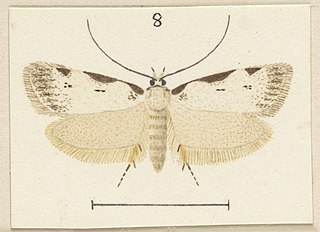
Izatha balanophora is a moth of the family Oecophoridae. It is endemic to New Zealand, where it is widespread in the North Island. Larvae live off the dead bark of kānuka. The adult moths are on the wing during December to March.

Izatha prasophyta is a moth of the family Oecophoridae. It is endemic to New Zealand, where it is known from the North Island, except Hawkes Bay or the Wairarapa. Larvae likely feed on rotting wood although larvae of this species have been reared on the fruiting body of the bracket fungus Bjerkandera adusta. Adults are on the wing from November to February.

Batrachedra filicicola, also known as the ring fern spore-eater, is a species of moth of the family Batrachedridae. It is endemic to New Zealand and has been collected in the North Island. The larvae of this species feed on the spores of the silver fern. Adults are on the wing in November and December. This species is attracted to light and has also been collected in the day by sweeping silver fern fonds.

Batrachedra psithyra, the spleenwort spore-eater, is a species of moth of the family Batrachedridae. It is endemic to New Zealand. This species has been observed in the North, South and Matiu / Somes Islands. This species inhabits overgrown grasslands or fern glades and have also been observed in gumland heath. The larvae of this species feed on fern sori including those on Histiopteris incisa. Adults are on the wing from November to January and tends to fly at sunset. At rest this species raises the front part of its body and when moving waves alternate antennae.

Batrachedra tristicta is a species of moth in the family Batrachedridae. It is endemic to New Zealand and has been found in both the North and South Islands. The larvae feel on the flowers and seed heads of rushes in the genus Juncus. The adults of this species are on the wing in March.

Heterocrossa eriphylla, also known as the lichen snoutlet moth, is a species of moth in the family Carposinidae. It is endemic to New Zealand. The larvae of this species feed on the healing wounds of New Zealand beech trees.

Heterocrossa exochana is a species of moth in the family Carposinidae. It is endemic to New Zealand.

Heterocrossa gonosemana is a species of moth in the family Carposinidae. It is endemic to New Zealand.
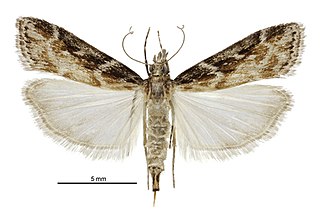
Scoparia molifera, also known as the leather-leaf Scoparia, is a species of moth of the family Crambidae. This species was first described by Edward Meyrick in 1926 and is endemic to New Zealand. It can be found in the North and South Islands. The larvae of this species make silk tunnels from which they mine the leaves of their host, the leather-leaf fern Pyrrosia eleagnifolia. Adult moths are on wing from December to February and are attracted to light.

Epichorista aspistana is a species of moth of the family Tortricidae. It is endemic to New Zealand and has been collected in Canterbury and Otago. This species inhabits moist grassy areas at altitudes ranging from sea level to 1650m. Larvae feed on species within the genus Acaena. Adults are on the wing in November to February.
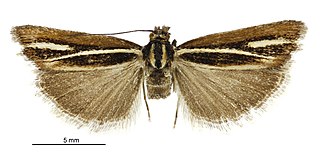
Orocrambus thymiastes is a moth in the family Crambidae. It was described by Edward Meyrick in 1901. This species is endemic to New Zealand, where it has been recorded from Southland. O. thymiastes prefers habitat that consists of boggy areas. This species is associated with Chionochloa rubra.

Glaucocharis elaina is a species of moth in the family Crambidae. This species was described by Edward Meyrick in 1882. It is endemic to New Zealand.

Pyrgotis plinthoglypta is a species of moth of the family Tortricidae. It is endemic to New Zealand and is found throughout the whole country. The preferred habitat of this species is native forest. The larvae of this species feeds on rimu leaves from under a silken web. It pupates in loose cocoons amongst rimu foliage. Adults are on the wing from October to May and are night flying. They are attracted to light and can be collected by beating their host tree. The adult insect resembles a small dried fragment of rimu foliage when at rest.

Eudonia manganeutis is a moth in the family Crambidae. It was named by Edward Meyrick in 1884. It is endemic to New Zealand.

Eudonia cataxesta is a moth in the family Crambidae. It was described by Edward Meyrick in 1884. It is endemic to New Zealand.

Microcolona limodes is a species of moth in the family Elachistidae. It is endemic to New Zealand. The larvae of this moth eat the seeds of endemic Myrsine species.

Kiwaia lithodes is a moth in the family Gelechiidae. It was described by Edward Meyrick in 1886. It is found in New Zealand.

Kiwaia pharetria is a species of moth in the family Gelechiidae. It was described by Edward Meyrick in 1885. It is endemic to New Zealand.
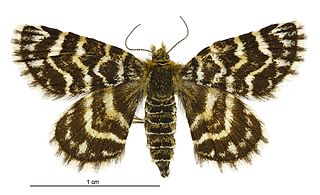
Notoreas hexaleuca is a species of moth in the family Geometridae. This species is endemic to New Zealand.
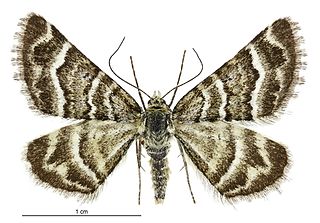
Notoreas paradelpha is a species of moth in the family Geometridae. It is endemic to New Zealand.






















